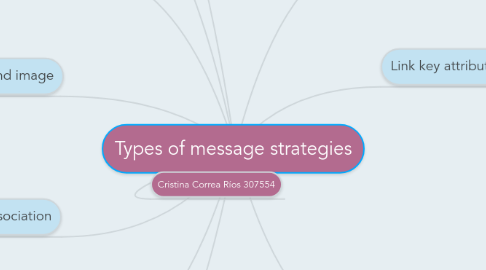
1. Affective association
1.1. Feel good ads
1.1.1. It's a common practice in political ads (TV Tropes, 2017)
1.2. Humor ads
1.2.1. People will pay more attention to a humorous commercial than to a serious one (Levitt, 2017)
1.3. Sex-appeal ads
1.3.1. They often relate the effectiveness of their products with attractiveness (Kokemuller, 2017)
2. Scare the consumer into action
2.1. Fear appeal ads
2.1.1. It threats the audience about something serious to engage them (Grimsley, 2017)
3. Change behavior by inducing anxiety
3.1. Anxiety ads
3.1.1. According to the book, advertisers use their product as a reason to alleviate the anxiety
3.2. Social anxiety ads
3.2.1. According to the book, it threats with negative social judgement
4. Define the brand image
4.1. Image ads
4.1.1. It attempts to create a positive picture of the product in the mind of the consumer (Business Dictionary, 2017)
5. Give the brand desired social meaning
5.1. Slice of life ads
5.1.1. There's a dramatic situation in which the product is presented as the solution (CBU Marketing, 2017)
5.2. Branded entertainment
5.2.1. According to the presentation from Blackboard, it refers to products that appear on movies on television shows
6. Resolve social disruption and cultural contradictions
6.1. Tie the brand to social or cultural movements
6.1.1. Millenials are specially attracted to Cultural Movement Marketing (Goodson, 2015)
7. Transform consumption experiences
7.1. Transformational ads
7.1.1. A form of emotional advertising that tries to create interest to buy the product (Dictionary Central, 2017)
8. Cristina Correa Ríos 307554
9. Promote brand recall
9.1. Repetition ads
9.1.1. It can build brand familiarity but it can also build fatigue (Magloff, 2017)
9.2. Slogan and jingle ads
9.2.1. A catchy phrase for the top of mind recognition (Newton, 2017)
9.3. Point of purchase branding
9.3.1. They try to influence the customer so he can make an impulsive buy (Watkins, 2017)
10. Link key attributes to the brand name
10.1. Unique selling proposition (USP ads)
10.1.1. It refers to the unique benefit that the brand gives to its customer according to the Blackboard presentation
11. Persuade the consumer
11.1. Reason why ads
11.1.1. It provides specific reasons to buy the product, works better in print than in broadcast (Barron's Educational Series, 2017)
11.2. Hard sell ads
11.2.1. There are enthusiastic sales people pushing you to buy the product (McFarlin, 2017)
11.3. Comparison ads
11.3.1. The advertiser claims the superiority of its product over his competition (Business dictionary, 2017)
11.4. Testimonial ads
11.4.1. According to the book of the class, there's a spokesperson that gives proof that the product works
11.5. Demonstration ads
11.5.1. It shows visually how the product works to the consumers (Greenwald, 2014)
11.5.1.1. Volvo Trucks with Jean Claude Van Damme
11.6. Infomercials
11.6.1. It focus on the benefits of the product and offer incentives to get you to call the number (McFarlin, 2017)

